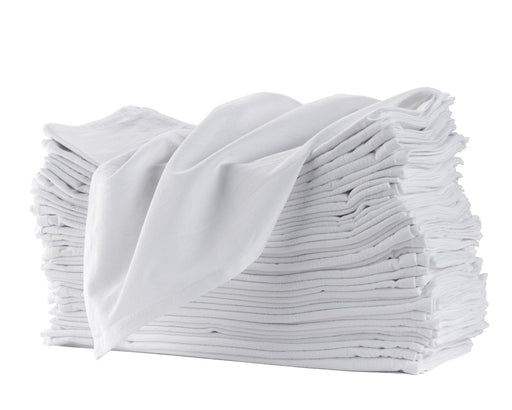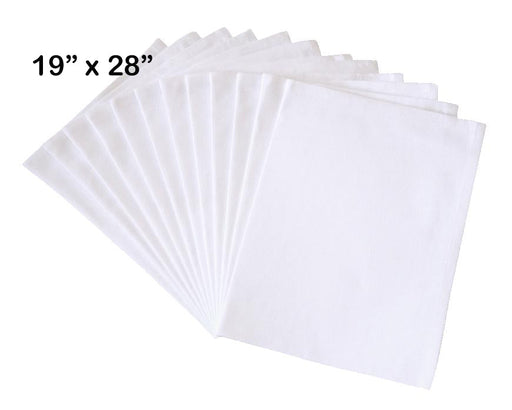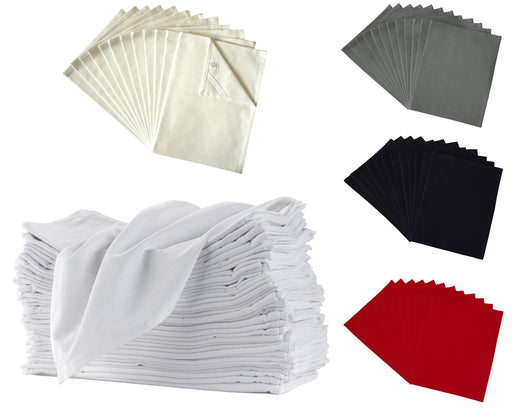Continental U.S. only.
Continental U.S. only.
Think about your kitchen for a moment. Can you imagine it without those trusty cotton tea towels hanging by the sink or tucked away in a drawer? Feels strange, right? For so many of us, tea towels are more than just kitchen accessories—they’re the unsung heroes that handle spills, dry our hands, and wrap around warm, freshly baked bread. But have you ever stopped to think about how these everyday cloths earned their place in our homes?

The story of cotton tea towels is a fascinating one that spans continents and centuries. It begins over a thousand years ago in Asia, particularly in India, where the cultivation and weaving of cotton first flourished. By around 1000 CE, India had become the world's leading producer of cotton textiles, crafting fabrics that were highly sought after from Japan to Europe. These textiles, known for their vibrant colors and intricate designs, captivated the global market. Indian cottons were celebrated for their quality and beauty, becoming essential commodities in trade routes that connected Asia with Europe and Africa.
Cotton's story begins long before it graced modern kitchens. As far back as the ancient civilizations, cotton was a fabric of both necessity and luxury. In the Indian subcontinent, cotton was not merely a material but a canvas for creativity. Weavers in regions like Bengal produced exquisite muslins, so light and delicate they were often referred to as “woven air.” Meanwhile, Gujarat became renowned for its vibrant, colorful prints that could brighten any room, thanks to the skillful application of resist dyeing and block printing techniques. These artisanal methods were perfected over generations, turning ordinary cotton into extraordinary works of art.
What made Indian cotton so unique was not just the quality of the fibers but the exceptional craftsmanship behind its production. The weavers of India, known for their attention to detail and innovative dyeing techniques, created textiles that were unlike anything else in the world. The result was a fabric that was beautiful, durable, and versatile, making it highly desirable in markets across Asia, the Middle East, and Europe. These textiles became the darlings of global trade, highly sought after for their quality and beauty.
The demand for Indian cotton textiles grew rapidly, turning cotton into one of the most traded commodities in the medieval and early modern world. By the 16th century, cotton had woven itself into the fabric of global trade, connecting Asia with Africa, the Middle East, and Europe in a complex web of economic and cultural exchanges. European traders, particularly the Portuguese, Dutch, and English, were captivated by the exotic textiles that featured patterns and colors unlike anything produced in Europe at the time. These textiles became so fashionable that they were sought after for clothing, household items, and even as symbols of status.
European manufacturers, however, struggled to replicate the unique qualities of Indian cottons due to a lack of expertise, techniques, and the vibrant natural dyes that made these fabrics so special. As a result, they heavily invested in importing Indian cottons, fueling global trade and creating a demand that reshaped the textile industry. European merchants became infatuated with these fabrics, importing them in large quantities and using them as templates to develop their own textile industries.
Fast forward to the 18th century, and cotton was about to change the world again. The Industrial Revolution marked a period of rapid technological advancement that forever transformed how we produce, trade, and consume goods. At the heart of this transformation? Cotton.
Driven by an insatiable demand for cotton textiles, European manufacturers began to innovate. The invention of machines like the spinning jenny, water frame, and power loom revolutionized cotton production, enabling factories to produce vast quantities of textiles at unprecedented speeds. These innovations allowed European factories, particularly in Britain, to outcompete their Asian counterparts, which were still reliant on traditional hand-spinning methods. The result was a massive expansion of the textile industry in Europe and the shift of the global cotton trade from Asia to the West.
Cotton was the first industry to undergo mechanization, becoming the largest industrial sector in Britain by the early 19th century. Suddenly, Europe, once a consumer of Indian cotton, became the global center for cotton textile production, exporting its goods worldwide. The mechanization of cotton production did more than boost Europe’s economy; it also democratized cotton textiles. Before the industrial boom, cotton fabrics were luxury items, reserved for the wealthy who could afford the high cost of imported goods. With mechanization, the price of cotton goods dropped significantly, making them accessible to a much wider audience.
As cotton became more affordable, it found its way into every corner of daily life—including the kitchen. The qualities of cotton—its softness, absorbency, and durability—made it an ideal material for household items like kitchen towels. Unlike linen, which was traditionally used for towels but required more maintenance, cotton could be easily washed and reused, making it perfect for everyday kitchen use.
By the mid-19th century, cotton towels had become a staple in homes across Europe and America, valued for their practicality and comfort. These towels were not just functional but revolutionary—a game-changer for home cooks and homemakers everywhere. The cotton kitchen towel, which could absorb moisture, stand up to repeated washes, and still look good, became a beloved companion in the kitchen, ready to tackle whatever messes came its way.
Fast forward to today, and cotton is still the fabric of choice for kitchen towels. Why? Because it works. Cotton is highly absorbent, soaking up spills and drying dishes with ease. It’s durable, standing up to the rigors of daily use and countless trips through the washing machine. And it’s soft, getting better with each wash—like your favorite jeans but for the kitchen.
But there's more to cotton's story than just its functionality. In an age where sustainability is on everyone's mind, cotton's natural fibers offer an eco-friendly alternative to synthetic materials. Cotton is biodegradable, meaning it won't linger in a landfill for centuries like some synthetic counterparts. Moreover, the production of cotton supports traditional farming practices in many parts of the world, helping to maintain biodiversity and sustain local communities.
Despite the rise of synthetic fabrics in the 20th century, cotton has maintained its place in households worldwide, especially in the kitchen. Many consumers today prefer cotton towels for their natural feel and their connection to a long tradition of quality and craftsmanship that dates back over a thousand years. By choosing cotton, consumers are supporting a sustainable, biodegradable product that has been a staple in homes for centuries.
So, why do cotton towels remain so popular? The answer lies in the unique properties of cotton. Cotton fibers are highly absorbent, capable of holding up to 27 times their weight in water, making them ideal for drying dishes and cleaning up spills. The fibers are also strong and durable, able to withstand repeated washing without losing their shape or texture.
Moreover, cotton is a natural, breathable fabric that allows air to circulate, helping to prevent the growth of mold and bacteria. This makes it perfect for kitchen towels that need to dry quickly and be reused multiple times. Cotton can be woven into various textures and patterns, from plush terry cloths to smooth flour sack towels, catering to different needs and preferences. And let’s not forget about aesthetics—cotton holds dye beautifully, resulting in vibrant colors and patterns that add a touch of style to any kitchen.
The journey of cotton towels from ancient India to modern kitchens is a testament to the fabric's enduring appeal and versatility. What began as a luxurious fabric traded along ancient routes has become an everyday essential in households worldwide. This transformation reflects changes in technology and economics and the timeless qualities of cotton that continue to make it a preferred choice for kitchen textiles today.
Cotton's global journey is a story of economic transformation, technological innovation, and cultural exchange that spans over a thousand years. Every time you reach for a cotton towel in your kitchen, you're part of a story that spans centuries and continents. It's a story of innovation, resilience, and timeless appeal—a story that has brought comfort and convenience to countless homes worldwide.
From its beginnings in the fields of India to its place in our modern kitchens, cotton has traveled a long and fascinating path. Its journey from an exotic fabric traded across continents to a household staple mirrors the broader history of global trade and industrial development. Today, when you grab that cotton kitchen towel to dry your hands or wipe up a spill, you’re not just holding a piece of cloth—you’re holding a piece of history.
So, the next time you’re in your kitchen, take a moment to appreciate that humble cotton towel. It’s more than just a tool—it’s a testament to a fabric that has stood the test of time, adapted to the needs of generations, and continues to be an essential part of our daily lives. Experience the enduring quality and timeless appeal of cotton with our range of kitchen towels at Mary's Kitchen Towels. Shop now to find the perfect towel that combines tradition, sustainability, and everyday practicality.

If you need red, gray, blue or black color please click here. ★ Multipurpose, available white or natural colors (unbleached), matching, wholesale ...
View full details
★ Current production time is 3-4 weeks. RE-SELLERS/WHOLESALERS/DESIGNERS: Please contact us for our wholesale prices if your volume is more than 1...
View full details
100% Cotton, comes in white (bleached) and natural (unbleached) color A uniform 19" x 28" rectangle, 130 thread count, flour sack napkins hemmed...
View full details
100% Cotton A uniform 27" x 27" square, 130 thread count, 3 oz each heavyweight flour sack dish towels and hemmed on all sides A corner loop for...
View full details
Attention Re-sellers, Wholesalers, and Designers: If you need to order more than 100 pieces, please contact us for our special wholesale prices. Pr...
View full details